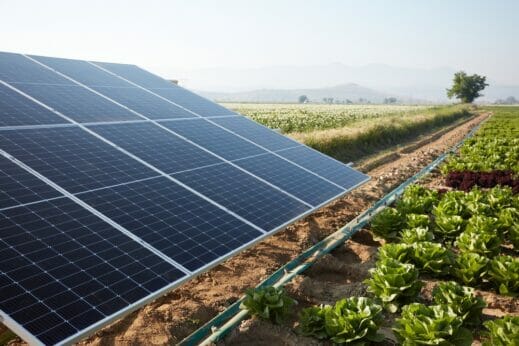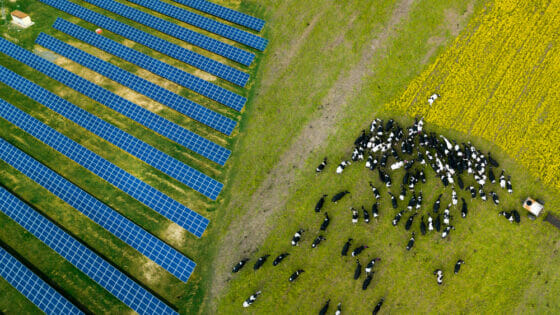As communities look to green energy infrastructure, farmers and developers often find themselves on opposite sides of the deal.

When an energy company proposed a 175-megawatt solar array in Greene County, Ohio last year, the community response was a nearly universal “no.”
Residents packed town hall meetings to tell elected officials not to put the facility in their backyards.
“Almost all of the feedback was negative,” says Greene County Commissioner Brandon Huddleson. Among the many objections was the project’s proposed location. “It was on 1,500 acres of prime farmland.”
Greene County has some of the best soil in the state for crop production, and residents didn’t want to see fertile fields disappear into a solar farm. Huddleson stressed that officials in Greene County aren’t opposed to solar energy, but they wished that solar developers could find a better location.
The Ohio Power Siting Board rejected the project in the face of overwhelming community opposition. While the siting board, which approves energy projects, has approved 65,000 acres of solar development and has another 27,000 acres in development, the alternative power source faces fierce opposition in corners of the state blanketed with pastures and crop fields.
Last year, the siting board rejected two other solar arrays based in part on worries over farmland, says siting board spokesperson Matt Butler.
“When you’re losing that farmland, there’s certainly a lot of pushback,” says Peggy Hall, an associate professor and field specialist in agricultural and resource law at the Ohio State University, who tracks cases involving rural solar energy.
Ohio is hardly alone.
As utility companies and state governments across the United States look to decarbonize power grids, the struggle against catastrophic climate change is coming face-to-face with the defense of agriculture.
With land prices already spiking in states such as Ohio, farmers worry that competition with deep-pocketed utility companies will drive up land values and price them out of their most lucrative fields.

Photography by Shutterstock.
Competition for prime land
In a 2022 report, the American Farmland Trust estimated that solar development will take up around 2.5 million acres in the United States by 2040. Of those acres, 83% will be farmland and roughly half will be the most valuable farmland.
It’s a small number compared to the nation’s nearly 893 million acres of farmland, and studies have generally found that solar projects in rural areas barely move land prices. But as more lucrative cropland is swallowed up by solar and wind developers, farmers worry their best assets are disappearing.
“Whenever you reduce the land base, you’re increasing competition for that land,” says Hall. “When you start getting some of these numbers thrown in that landowners are receiving for these projects [solar developers pay between $250 and $1,000 per acre per year], you start worrying about what kind of impact that is going to have on land values.”
Prime farmland is often an ideal space for solar arrays, say experts. Farmers and solar developers both need land that’s relatively flat, and the most valuable fields also tend to sit close to the transmission lines to which solar arrays need to connect.
Farmland “has been cleared of rocks and trees already,” says Francis Pullaro, executive director of Renew Northeast, an advocacy group that works with environmentalists and renewable energy developers. “And if farmland is close to a substation, that lowers the cost of the project by shortening the distance between the project and where it has to interconnect” with the power grid.
Growers—most of whom lease at least a portion of their land—say they don’t have the resources to outbid wealthy solar developers. Illinois farmer Jim Reed says he hesitated when approached about a solar array on his Piatt County farm.
“Piatt County has some of the best farm ground in the whole world,” he says. “It was the top-ranked county in the entire nation and soybean yield with the best soils anywhere, so it would be a shame to cover up that dirt with something that takes away from the food production.”
On the other side of the equation, solar development can keep farmers in business.
“The ability to site renewables on farmland can be a really important source of additional income that can be relied upon during drought years or when commodity prices are down,” says Gregory Wetstone, CEO of the American Council for Renewable Energy.
And with time running out to avert the worst impacts of climate change, scientists and environmentalists say that solar arrays need to go somewhere.
Buckeye state opposition
Last year, Ohio had around 13.5 million acres of farmland, a dip of 100,000 acres from the year before, according to the USDA.
While only 92,000 acres (less than one percent) are dedicated to solar development in Ohio, the loss of significant acreage can be devastating to individual communities, says Hall. “If you start taking away thousands of acres out of agricultural production, you are affecting the rural economy.”
And solar is just one of many developments encroaching on agriculture, says Dale Arnold, director of energy, utility and local government policy for the Ohio Farm Bureau. Developers have for years built housing, industrial facilities and commercial properties on former cropland. However, solar grabs headlines and attention because it takes up hundreds or thousands of acres at once, as opposed to a housing project that is built one house at a time.
“You need to look at all four corners of the box,” says Arnold.
The three solar developments rejected by the siting board targeted rural communities with sparse populations and roads abutted by corn and soybean fields on both sides.
Public interest is among the criteria the siting board must consider before approval; the three projects could not meet that standard with unanimous opposition from local governments, says Butler.
Rural communities opposed to solar got an assist from Ohio’s General Assembly in 2021, when the legislature approved a bill that gave townships the right to summarily reject renewable energy projects.
Republicans in the overwhelmingly conservative state legislature cited the need to return more control to local governments, but they never granted townships the right to reject oil and gas development.
Resistance to rural solar cuts across ideological lines. Oregon, a predominantly blue state, passed a law in 2019 restricting solar development on prime farmland.
However, support for farmers who lease their land to solar developers also knows no political party.
In conservative heartland states such as Iowa, property rights have generally won out over skepticism toward renewable energy.
“The policy we have right now reflects back to the landowners,” says Denny Friest, president of the Iowa Corn Growers Association and a corn and soybean farmer. “They have the right to do what they want [with their property].”

Photography by Shutterstock
Seeking middle ground
In the face of opposition, clean energy advocates seek paths that satisfy farmers, developers and environmentalists.
Rather than restricting solar projects on prime farmland, the state of Connecticut requires its siting board to give extra consideration to proposals on valuable cropland. State legislators see the law as a compromise that allows for renewable energy development but accounts for agricultural concerns.
“I think there is a happy medium to be found and I hope this is it,” says Connecticut state representative Joe Gresko.
However, not everyone is happy with the law, which makes the process more expensive for solar developers and doesn’t similarly restrict other forms of electricity, says Pullaro, with Renew Northeast.
As solar proliferates, farmers have found ways to coexist with solar developers, grazing cattle or growing specialty crops that require less sunshine underneath raised panels. “We really need to highlight that you can have renewable development without giving up the opportunity to farm a ranch simultaneously,” says Wetsone.
Solar panels on barns and unusable soil is another possible middle ground.
Keith Bishop, owner and CEO of Bishop’s Orchards near Guilford, Connecticut, has two solar arrays on his farm, one on a ground mount and another on the roof of one of his buildings.
The ground-mounted solar takes out around an acre of ground, although it was on a hillside with a granite wedge, so it did not impact the orchard’s production. But Bishop cautioned that he could only install so much solar before impacting his crop yields. “I would like to put in more, but we’re limited over where we can do it.”
Resistance in some parts of the country may naturally wane as solar arrays become more common and farmers gain interest in the projects. “I tell farmers ‘you need to be involved in those discussions,’” says Arnold. “Because if you’re not at the table, you will be part of the menu.”
Why not coat the massive warehouses and parking lots in urban and peri-urban areas with solar? Then the energy is where it is needed, also cutting down on the need for huge transmission lines cutting through often beautiful and unique rural landscapes?
Has anyone studied the effects of solar panels on the earth beneath them? I know for a fact that fewer plants will grow, and that will likely adversely affect soil chemistry and soil moisture content. On the other hand, in a desert environment, the cooling effect it will have may well improve soil moisture content and soil chemistry as a result. This may result in improved plant growth. Either way, has anyone considered what this may do to those ecosystems and the Earth at large? I thought not. Looking ahead and thinking things through is not a hallmark of climate… Read more »
Great point Deirdre and Jed is dead on with his questions. Also, not just the land, location but this is rural with its culture – its not for corporate. We know they don’t want then on Martha’s Vineyard along with the stupid windmills. In my reading, the only thing that makes sense is its a land grab to reduce the food supply. They (government & corporate & politicians) have consolidated the beef, the pork, the chicken and most other processing of food, why not the land. When are we going to stand up and stop this. This is not alternative… Read more »
If there is a thermal runaway with a lithium-ion battery or solar fire you will have hazmat contamination of the soil that leaches into the ground and then into the water ways. It will be costly to combat the fire and think about the wildlife. Humans will be affected